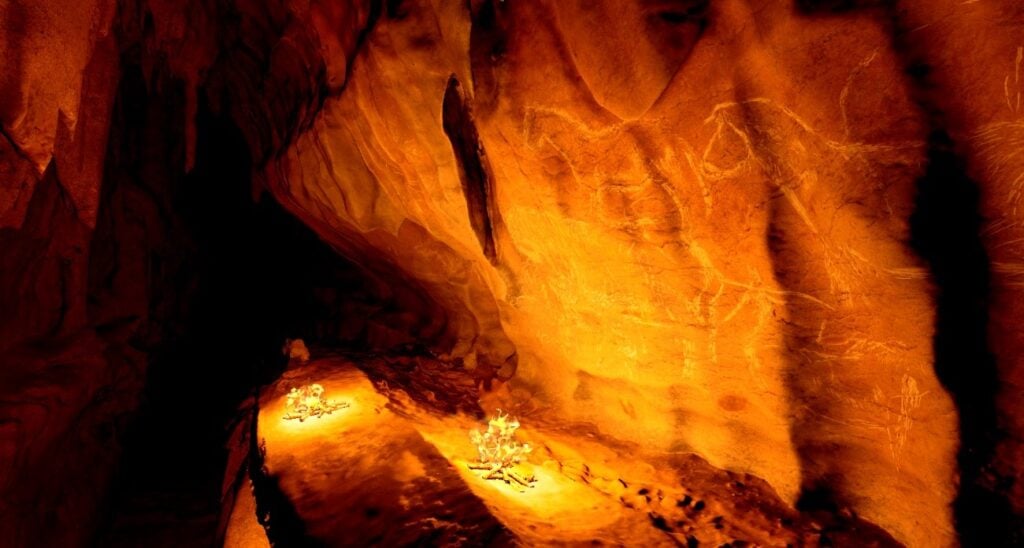The dozens of animal engravings discovered in the Atxurra cave in Basque Country, Spain prove that there is planning before artistic production during the Upper Palaeolithic
16 Jul 2024

The Atxurra cave (Basque Country, Spain) is an exceptional place to learn about the Magdalenian artists in Europe. A unique archaeological context preserved inside the cave is presented for the very first time. It is a ledge four m high and 300 m from the entrance, where dozens of animals engraved 14,000 years ago (bison, goats, horses, deer, etc.) can be seen. The stone tools used for their creation and the remains of charcoal derived from their illumination by fire were found next to them. It was possible to correlate each type of groove with a specific tool found at the foot of the panel. The study has proven that there was prior planning of the artistic production, both in terms of the iconographic aspects, as well as their location and the lighting systems. They used juniper and oak both for the torches and for small fireplaces. In addition, the data indicate that the panel was decorated to be viewed by third parties from different positions and was illuminated specifically for this purpose. This evidence supports the role of rock art as a visual communication system in Upper Palaeolithic societies.
Atxurra cave has a decorated assemblage composed of more than a hundred engraved animal depictions. All of them are in deep parts of the cave and most of them are hidden in raised areas, away from the main path. The main sector is the “Ledge of the Horses” located at 330 m from the entrance of the cave. It is a space of 12 m long and 1.5 m wide, elevated 4 m above the cave floor. This area includes almost fifty engraved and painted animals accompanied by a dozen flint tools, three fireplaces, and around one hundred charcoal fragments from torches. This extraordinary archaeological record allows us to value the complexity of the artistic production inside the caves during the Upper Palaeolithic. Our study has confirmed that there is planning prior
to artistic production, both in terms of the iconographic aspects (themes, techniques, formats), its location (visibility, capacity), and the lighting systems.
Authors: Diego Garate (Instituto Internacional de Investigaciones Prehistóricas de Cantabria (IIIPC), Universidad de Cantabria), Olivia Riverto (Departamento Prehistoria, Historia Antigua y Arqueología, Universidad de Salamanca), Joseba Rios-Garaizar (Arkeologi Museoa, Calzadas de Mallona s/n), Ma Angeles Medina-Alcaide (CNRS, Ministère de la Culture, PACEA, UMR 5199, Université de Bordeaux), Martin Arriolabengoa (Departamento de Geología, Euskal Herriko Unibertsitatea/Universidad del País Vasco), Inaki Intxaurbe (Departamento de Geología, Euskal Herriko Unibertsitatea/Universidad del País Vasco), Juan F. Ruiz-Lopez (Departamento de Historia, Universidad de Castilla La Mancha), Ana Belen Marin-Arroyo (Evoadapta, Departamento de Ciencias Históricas, Universidad de Cantabria), Juan Rofes (School of Archaeology, University of the Philippines Diliman/Archéozoologie, Archéobotanique: Sociétés, Pratiques et Environnements/National Museum of the Philippines), Paula Garcia Bustos (Departament d’Història i Arqueologia, Universitat de Barcelona), Antonio Torres (Instituto Internacional de Investigaciones Prehistóricas de Cantabria (IIIPC), Universidad de Cantabria) and Sergio Salazar (Instituto Internacional de Investigaciones Prehistóricas de Cantabria (IIIPC), Universidad de Cantabria)
Read the full paper: https://www.nature.com/articles/s41598-023-44520-w
